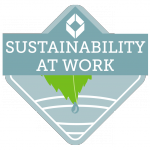
Engaging Management
How do you get people at the top of your organization to engage on sustainability? Ask them what your customers expect today.
Sustainability is a marketplace driven imperative; it is not about compliance. A big myth is that corporate sustainability is another cost center, like EHS compliance or legal departments. Instead of focusing on compliance, get up to speed on the business case – the costs and productivity benefits to your company and customers stemming from initiatives focused on waste, energy and resource efficiency. This business case is critical to demonstrating the potential advantages of “doing well by doing good” and catalyzing action.
It’s interesting what happens when you step up and ask. I wasn’t at my first job more than two weeks when I phoned the executive in charge of 8,000 employees to ask what we were doing to accurately perform risk assessments at sites to reduce human exposure to hazardous substances. I was passionate – I had taken on a personal research project for my Master’s thesis that aligned with my agency’s top priorities. I had good questions that had no answers.
The key is to start asking. Does our company have clear sustainability commitments that resonate with our customer’s values? How do we know we’re walking the talk – what do we measure? Do we measure the real costs and benefits of our waste diversion strategies? Or simply, how much are we driving to a legitimately better use?
And once you ask, be ready to listen…because leaders love to talk. Stay in listening mode and solve, don’t sell. That’s how good leaders behave today with their customers, so they will appreciate it in you. As CEO Chris Viehbacher from the pharmaceutical company Sanofi-Aventis puts it, “it used to be R&D would have a molecule, a medicine or a technology…and we would look for a rich patient. Now we start with patients – how can we help them?”
When I phoned that executive from my first job and asked about exposures to hazardous substances, I employed active listening. In that moment, it wasn’t about my idea or my career path – it was about safety and risk reduction. I brought the issue into the spotlight, but true enlightenment occurred when I allowed leaders to talk about what they knew. Because I took the time to actively listen, I was able to formulate possible options to resolve the situation.
Two weeks after my chat with that executive, our office was appointed lead region to figure out a solution. Over the next several months I helped develop a standard methodology for risk assessment and building local capacity to manage and communicate sustainability risks.
I’ve built upon these learned best practices throughout my entire career. Stand for decisions on priorities. Focus on achieving consensus on no more than three to five top priorities, and present either/or solution options for these priorities. Leaders do not want a slew of options…you will not find them in the buffet lines at restaurants. Plan clear deliverables and metrics for achieving results. Focus on solutions, not processes or systems. While we need system approaches, save that discussion for your brainstorming meetings.
Now that you are engaged with your leadership, don’t try to develop and implement an action plan by yourself. You are the glue…this may not sound sexy, but it’s vital. Success will depend on teamwork. You will need to engage those that can make the plan come to life – mid-management, team/department leads, passionate associates – all along the way. This is the time to host those brainstorming sessions to define processes and systems. Once our region was appointed to figure out a solution, we formed a national network to create a site specific methodology for estimating exposure to hazardous substances, and develop a strategy for building field capabilities to do so. It wasn’t every man for himself, it was all hands on deck.
Once you roll out the plan, be sure to reinforce the messaging with tangible examples of action. Quote, publish or video your leaders talking about the company’s sustainability commitments. Find other leaders in mid-management and on the shop floor and catch them doing things that demonstrate innovative ways that words (i.e., the company’s commitments) are being put into action. The majority of companies work in silos – no one feels the pain of this natural resistance to collaboration greater than those at the top. The whole is truly greater than the sum of the parts. Sustainability imperatives must be shared to be successful, and approaches to tackling the imperatives must integrate marketing, R&D, operations and communications expertise.
From the ask to the implementation, continuously update the business case and prepare for every briefing with the concept of WHOGAS – who gives a s%#@. In order for you to engage your leaders, you need to hit the points that mean the most to them.
I look forward to hearing how these tips work for you. Submit your thoughts in the comments section below.
Connect with Susan via social media: Twitter: @SusanMGraff LinkedIn: Susan Graff
